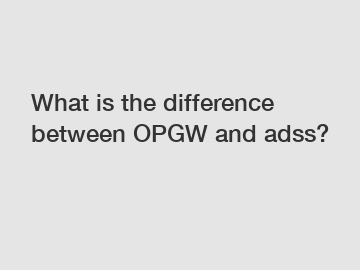What is the difference between OPGW and adss?
In the present technology-driven world, reliable and efficient communication networks have become the lifeblood of various industries. Optical fibers play a crucial role in ensuring seamless data transmission, and two commonly used cable types in this domain are Optical Ground Wire (OPGW) and All-Dielectric Self-Supporting (ADSS) cables. Although both serve similar purposes, there are distinct differences that demand attention for making informed decisions. In this article, we will unravel these disparities to help you understand which option suits your specific needs. .
Understanding OPGW Cables:
OPGW cables blend power transmission and fiber optic communication. They are typically implemented in electrical power transmission systems, where they serve a dual purpose of supporting power line conductors and providing a communication link. The unique construction of OPGW cables ensures they can withstand high-voltage environments while securely housing fiber optic elements within their sturdy metal layers. This integrated approach eliminates the need for separate power towers and communication lines, optimizing space utilization in a cost-effective manner.

Exploring ADSS Cables:
ADSS cables, on the other hand, are exclusively designed for communication purposes. Unlike OPGW cables, these self-supporting units do not carry electrical power. ADSS cables consist of a central fiberglass core that houses one or more optical fibers within a protective coating. Unlike OPGW cables, ADSS doesn't require any metallic components for strength or electrical grounding. Instead, ADSS cables utilize the principle of tensile strength to bear their weight and can be deployed directly alongside existing power lines.
Differentiating Factors:
1. Structural Variations:
The most apparent distinction between OPGW and ADSS cables lies in their structural composition. OPGW cables consist of a steel or aluminum core surrounded by layers of steel wires or aluminum strands. This robust layered structure provides mechanical strength and the means to dissipate electrical currents. In contrast, ADSS cables possess a central fiberglass core, allowing them to be lighter and more flexible, while still ensuring sufficient mechanical strength to withstand environmental factors such as wind and ice.
2. Electrical Grounding:
OPGW cables, being integrated into power transmission systems, provide a pathway for grounding electrical conductivity. The metal components in OPGW cables effectively dissipate electrical currents, mitigating the risk of electrical interference or damage. ADSS cables, not carrying power, lack this grounding function and are therefore not used for power system grounding.
3. Span Length and Sag Considerations:
OPGW cables are typically associated with longer span lengths, often exceeding 1,000 meters. This characteristic links back to their integration within power transmission lines, enabling fiber optic communication across vast distances. In contrast, ADSS cables are generally employed for shorter distances, rarely surpassing 700 meters. Due to their lighter weight and higher flexibility, ADSS cables accommodate shorter spans and varying degrees of cable sag to ensure optimal performance.
4. Installation Considerations:
While OPGW cables demand the involvement of specialized equipment and skilled technicians for installation and maintenance, ADSS cables offer a more straightforward and time-efficient installation process. The self-supporting nature of ADSS cables simplifies installation, reducing both time and labor costs. Conversely, OPGW cables require comprehensive expertise for installation, typically involving the involvement of power line crew teams.
Conclusion:
Understanding the differences between OPGW and ADSS cables is crucial when it comes to selecting the appropriate option for your network requirements. While OPGW cables seamlessly integrate power transmission and fiber optic communication, ADSS cables solely specialize in providing reliable communication. The structural variations, electrical grounding disparities, span length considerations, and installation requirements are all important factors to evaluate before making an informed decision.
Ultimately, your choice between OPGW and ADSS cables should be based on the specific needs of your project, such as distance requirements, desired electrical grounding, and installation constraints. Both cables have their distinct advantages and limitations, and considering these factors will help you develop a robust and reliable network infrastructure tailored specifically to your communication needs.
If you want to learn more, please visit our website China OPGW hardware manufacturer, fiber joint box, adss suspension clamp manufacturer.


